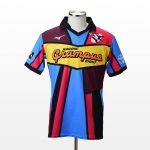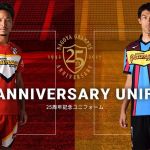
From Osaka to the stars: the hipster story of Mizuno
If Gianfranco Zola and Nakamura love them, we love them too
September 19th, 2018
Until 1980, Mizuno’s logo was a simple "M". Essential, to the limits of the trivial, certainly effective. In those same years, however, the brand was expanding, conquering new frontiers in a Risiko style match that involved different states and different sports. There was a need to give a sign of change, an unexpected novelty, a distant look. Hundreds of proposals were made for the new logo, but all were rejected. In the end, the right idea came: it was dropped from above, literally.
Noboru Kono, to create the new symbol, was inspired by a section of a painting by Kenjiro that represented the connections between the planetary orbits. A small detail that contained in itself an equally small, but great universe. The vocation of Mizuno expressed through a small door, which once opened showed a world without borders: the Runbird becomes the symbol of Mizuno’s universality brand and its gaze always turned to the stars.
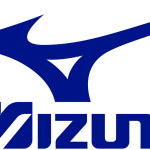
A hundred years of history
Mizuno’s history starts from a distance, in a temporal and geographical sense: it begins in Osaka, Japan, at the beginning of the twentieth century, when Rihachi Mizuno decided, in agreement with his brother, to open the Mizuno Bros in 1906 after seeing a baseball game. Yes, the story of Mizuno starts from afar also "sportily": Rihachi Mizuno saw his first baseball game in Kyoto and became passionate about that sport imported from America forty years ago. In the sign of the shop opened by the "Bros" you can clearly notice what kind of merchandise was preferred by the pair of Japanese brothers: at the center, at the top, there is the image of a beater shaking hands with another player; along the entire facade appear written in both English and Japanese, and in the window, on the left, you can also see two rackets: all highlights the international and multifaceted tone that would characterize the entire history of Mizuno. Which, as mentioned, started from baseball. But it did not stop there.
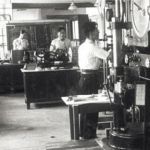
The ascent was rather rapid, like an ace dropped from above that suddenly collected all the cards on the table in a single deck: Mizuno, from its foundation until the Second World War, supported several editions of the Olympics and expanded the range of his sporting goods, starting to produce ski equipment (1927), marrying golf in 1933, embracing tennis in 1943. In 1934, in a blaze of dates and sport, Mizuno implemented his production by opening a small factory in Osaka.
Only the war broke Mizuno’s path: the company was forced by the Japanese government to stop the production of sports goods to devote themselves to the production of military equipment. Mizuno, however, never abandoned his sporting vocation. And in the next fifty years it has continued its expansion, in the "physical" world and in the sport world: thanks to the leadership of Jack Curran, in 1982 the company managed to enter the American market and with Masato Mizuno (Rihachi’s nephew), finally, came the real international turning point: "The grandfather founded the company, the father introduced technological innovations: now it's my turn to expand it and make it truly international," he once said at Time. In the late 1990s, Mizuno was a leader in the American baseball industry and had further expanded the range of sports: baseball, tennis, golf, skiing, athletics, basketball, rugby, table tennis, boxing, handball. And football too.
The ultimate hipster football brand
In a world of sponsors dominated by the various adidas, Nike, Puma and so on, Mizuno stands in contrast, is the exception. Someone has also included it in the hipster football manual, and the shoe is often included in the charts of the "Models that made history", thanks to the image of Rivaldo: his Morelia have entered the common imaginary, and perhaps the Brazilian is the mirror par excellence of the company in the world of football. An essential style, sober, the color of the shoe that contrasts with that of the company symbol (white on black), kangaroo skin, comfort placed on top of everything. And it is immediately hipsteria:
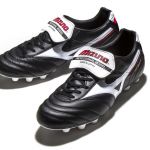
Even in its latest variants, the Mizunese shoe (born in 1985) has always maintained the same style. Colors have changed, yes, quality has also changed, thanks to the latest innovations to which Mizuno has always been careful; the shoe, however, is the same as always. In a market that continually changes in the search for the hit effect, Mizuno has relied on absolute simplicity, continuity, the sober and calm style of those who say "we are these, in Japan it is used like this: comfortable and simple shoes". And several players have paid attention to the spirit of the old Rihachi, who came to visit him at night and advised him to choose the right shoe. And so, in the Mizuno team we can find, in no particular order: the aforementioned Rivaldo, Nakamura, Careca, Ronaldo, Bebeto, Hulk, Honda, Santa Cruz, Aimar, Kluivert (father, of course), Gianfranco Zola.
Ah, there is also Roberto Carlos. Indeed: in recent years, perhaps, there has been above all Roberto Carlos. The former full-back is a major sponsor of Mizuno ‘cause he used the Morelia for much of his career. In 2015, on the anniversary of the model's release, he also received from the Japanese company a special version of the Morelia: golden, complete with a Brazilian flag and an engraving of the name Manuela, daughter of the former Real Madrid’s player. Which in this video tells us why choose Mizuno:
Then there is a curious case. So curious. The most important player (or at least the most known) to be on the pitch with the Mizuno at his feet, lately, was Thiago Motta: in the 2015-2016 season, the former PSG midfielder was one of the few illustrious players of the Ligue 1 do not have a sponsorship contract with Nike, adidas or Puma. Free to choose, the Italian-Brazilian opted precisely for Mizuno: Morelia II version for Thiago Motta. No contractual links, only a choice dictated by the sober and splendid comfort of a timeless model.

From Osaka to the stars
The technical sponsor Mizuno, over the years, has been chosen by several Japanese teams, of course. The brand has struggled to break through in Europe, but there were some exceptions: Marseille chose Mizuno for the 1995/1996 season, while Fiorentina wore the Runbird in the 2001/2002 season, which then culminated with the tremendous double relegation + bankruptcy. The iconic beauty of those sweaters, however, remains. Also because he also wore an Emperor
In Japan Mizuno decidedly more: he depopulated in the nineties, giving vent to all his hipster soul and colorful. Some sweaters are really special, like the special ones for the 25th anniversary of Nagoya Grampus: they have the same design as those of 1993, they look like a backpack from the Seven catapulted in 2018, or the card of a Sammontana ice cream cone. wonderful:
In Italy, in the whirlwind of technical sponsors, the only team to have chosen the Mizuno this season was Cesena, which currently plays in Serie D: "We immediately thought that this partnership could be the right fly to get back into the world of football, both with technical clothing and footwear, and return to assert our presence on the market as a quality brand," said Eugenio Ceravolo, Teamwear and Team Sports Promotion Manager of Mizuno Italia. The two companies have signed a three-year agreement, and Mizuno will take care of the all-round Cesena clothing, from official jerseys to training ones, including the youth sector. Mizuno style:

Among other things, the next Cesena’s purchase could be Iniesta. Wait: what does Iniesta have to do with Cesena? At the moment nothing, but the January market is not so far, after all. And during a training session with Vissel Kobe, in Japan, Don Andrés was pinched with a pair of Mizuno on his feet, despite his connection with Nike. According to some, those worn by Iniesta would be Mizuno Morelia Neo II:
Iniesta entrenó con las Mizuno Morelia Neo 2. pic.twitter.com/EHxtuQTGay
— Botas de futbol (@BotasToop) 7 settembre 2018
One of the lightest shoes ever, just 180 grams of weight, the usual comfort of Morelia and kangaroo skin. It's hard to say if Iniesta is about to leave Nike to marry the Mizuno cause. It's just a workout, after all, but one thing is clear: when a player has the chance to choose, he chooses Mizuno. Ah, final note: some time ago, a certain Fernando Torres took to the field with the Sagan Tosu wearing Mizuno (also in this case, model Morelia Neo II, however white), abandoning Adidas after 5 years of sponsorship.
From a small factory in Osaka to Fernando Torres: a very long connection, a trajectory lasting more than a hundred years and enclosed in the cropping of a painting. The Runbird at the feet of a champion, of a star. Mizuno started from the bottom, he looked at distant planets and reached them, carving out his space in the galaxy of sports brands.








































.png)


.jpg)













.jpg)




















